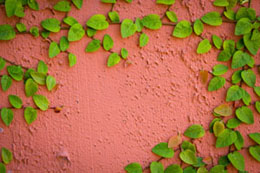Flowering vines definitely look beautiful and enhance the look of the garden or home when used esthetically. Read this Buzzle article to know more.

Arbors, walls, trellises, and pillars covered with vines attract attention and enhance the appearance of a house. These vines are an essential part of flower gardens and are known to attract the hummingbirds and butterflies. If you are planning to plant a variety that flowers, then it is advisable to know it's two basic types and the ideal region or zone for its growth.
Zones
Not all the flowering vines can survive in every weather condition. Hence, United States has created a map that indicates a specific zone for every vine. Each zone indicates an ideal temperature for growth of every species. These zones are numbered and are allotted various colors. For example, flowering vines zone 5 indicates, that the temperature of that zone is -20 to -10 degree Celsius and is suitable for clematis and Boston Ivy, etc. The temperature of vines zone 7 is 0 to 10 degree Celsius and is suitable for trumpet vine and climbing lily. Flowering zone 9 indicates that the temperature of this zone is 20 to 30 degree Celsius and it is ideal to grow Hydrangea and Virginia Creeper.
The zone map is based on average temperatures, so you can choose from vines outside your zone if you are closer to that particular zone. For example, if the plant is recommended for zone 3 and you are closer to zone 4, you can still grow that vine according to the temperature.
Annual Varieties
These are ideal for shade as they grow to their optimum length and size in one season. They also have a fast growth rate growing up to 20 feet in one season. They do not hold the walls tightly. Moon flowers, cup and saucer, hyacinth bean, morning glory, sweet potato, hops are some of the annual varieties. You need to shade the roots and provide sunlight to the tops, since it enables faster growth.
Morning Glory: Morning glory produces flowers of various colors but the most common color is blue. Its flowers have unique characteristic - they open at dawn and close when it's very sunny. It requires a fence or lamp post as a support to grow.
Black Eyed Susan: Generally blooming in summer, it produces dark yellow and deep orange color flowers. The throats of these flowers are very dark and so they got the name, black eyed Susan. You can shape this variety according to your choice.
Cardinal Climber: It is again one of the annual flowering vines that flourishes in summer. It produces tubular flowers that are dark red, maroon, and crimson in color. These brightly-colored flowers are sure to attract the birds and butterflies.
Perennial Varieties
Perennial vines grow continuously in each season. They increase in length, size, and flower every season. Ornamental sweet peas, passion flower vines, scarlet runner, clematis, wisteria, jasmine, lilies, etc., are some examples. These are available in various vibrant colors, such as dark-blue, deep-red, flashy-white, and purple, etc. Perennial vines require soil that is rich in nutrients to grow in a healthy manner. Their roots also need to be shaded from the harsh sunlight.
Clematis: Clematis is intense, beautiful, and vibrant. It is available in myriad hues and shapes, and can gel well with any kind of theme garden. You can also grow it in trellises in the balcony. They certainly serve as an eye candy for everyone.
Honeysuckle: This is one of the most beautiful climbing flowering vines. You can also use it as trumpet flower vines, as it has trumpet shaped flowers. It produces wide range of colorful flower coupled with unique fragrances. It is also endowed with red and black berries.
Jasmine: Common jasmine generally grows as a shrub with some support. It has a pleasing aroma. Winter jasmine is again one of the toughest vines, that can bear harsh cold winds.






 Arbors, walls, trellises, and pillars covered with vines attract attention and enhance the appearance of a house. These vines are an essential part of flower gardens and are known to attract the hummingbirds and butterflies. If you are planning to plant a variety that flowers, then it is advisable to know it's two basic types and the ideal region or zone for its growth.
Arbors, walls, trellises, and pillars covered with vines attract attention and enhance the appearance of a house. These vines are an essential part of flower gardens and are known to attract the hummingbirds and butterflies. If you are planning to plant a variety that flowers, then it is advisable to know it's two basic types and the ideal region or zone for its growth.